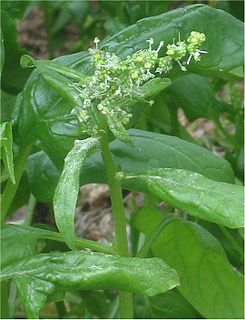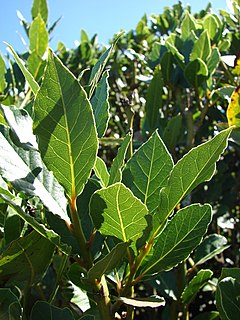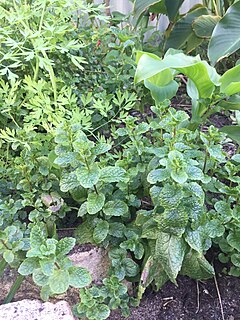Related Research Articles

Apollo is one of the Olympian deities in classical Greek and Roman religion and Greek and Roman mythology. The national divinity of the Greeks, Apollo has been recognized as a god of archery, music and dance, truth and prophecy, healing and diseases, the Sun and light, poetry, and more. One of the most important and complex of the Greek gods, he is the son of Zeus and Leto, and the twin brother of Artemis, goddess of the hunt. Seen as the most beautiful god and the ideal of the kouros, Apollo is considered to be the most Greek of all the gods. Apollo is known in Greek-influenced Etruscan mythology as Apulu.

The bay leaf is an aromatic leaf commonly used in cooking. It can be used whole or in a dried or ground form.

Lemon balm is a perennial herbaceous plant in the mint family and native to south-central Europe, the Mediterranean Basin, Iran, and Central Asia, but now naturalized elsewhere.

Pythia was the name of the high priestess of the Temple of Apollo at Delphi. She specifically served as its oracle and was known as the Oracle of Delphi. Her title was also historically glossed in English as the Pythoness.

Daphne, a minor figure in Greek mythology, is a naiad, a variety of female nymph associated with fountains, wells, springs, streams, brooks and other bodies of freshwater. She is said by ancient sources variously to have been a daughter of the river god Peneus and the nymph Creusa in Thessaly or of Ladon or Pineios, and to Ge.

Spinach is a leafy green flowering plant native to central and western Asia. It is of the order Caryophyllales, family Amaranthaceae, subfamily Chenopodioideae. Its leaves are a common edible vegetable consumed either fresh, or after storage using preservation techniques by canning, freezing, or dehydration. It may be eaten cooked or raw, and the taste differs considerably; the high oxalate content may be reduced by steaming.

Echinacea is a genus of herbaceous flowering plants in the daisy family. It has ten species, which are commonly called coneflowers. They are found only in eastern and central North America, where they grow in moist to dry prairies and open wooded areas. They have large, showy heads of composite flowers, blooming in summer. The generic name is derived from the Greek word ἐχῖνος, meaning "sea urchin", due to the spiny central disk. These flowering plants and their parts have different uses. Some species are cultivated in gardens for their showy flowers. Two of the species, E. tennesseensis and E. laevigata, are listed in the United States as endangered species.

A wreath is an assortment of flowers, leaves, fruits, twigs, or various materials that is constructed to form a circle.

Acorus calamus is a species of flowering plant with psychoactive chemicals. It is a tall wetland monocot of the family Acoraceae, in the genus Acorus. Although used in traditional medicine over centuries to treat digestive disorders and pain, there is no clinical evidence for its safety or efficacy – and ingested calamus may be toxic – leading to its commercial ban in the United States.

Laurus nobilis is an aromatic evergreen tree or large shrub with green, glabrous (smooth) leaves. It is in the flowering plant family Lauraceae. It is native to the Mediterranean region and is used as bay leaf for seasoning in cooking. Its common names include bay tree, bay laurel, sweet bay, true laurel, Grecian laurel, or simply laurel. Laurus nobilis figures prominently in classical Greco-Roman culture.

Viola odorata is a species of flowering plant in the genus Viola, native to Europe and Asia. This small hardy herbaceous perennial is commonly known as wood violet, sweet violet, English violet, common violet, florist's violet, or garden violet. It has been introduced into North America and Australia.

Ocimum tenuiflorum, commonly known as holy basil, tulsi or tulasi, is an aromatic perennial plant in the family Lamiaceae. It is native to the Indian subcontinent and widespread as a cultivated plant throughout the Southeast Asian tropics.

Cinnamomum tamala, Indian bay leaf, also known as tejpat, tejapatta,Malabar leaf, Indian bark, Indian cassia, or malabathrum, is a tree in the family Lauraceae that is native to India, Bangladesh, Nepal, Bhutan, and China. It can grow up to 20 m (66 ft) tall. Its leaves have a clove-like aroma with a hint of peppery taste; they are used for culinary and medicinal purposes. It is thought to have been one of the major sources of the medicinal plant leaves known in classic and medieval times as malabathrum.

A laurel wreath is a round wreath made of connected branches and leaves of the bay laurel, an aromatic broadleaf evergreen, or later from spineless butcher's broom or cherry laurel. It is a symbol of triumph and is worn as a chaplet around the head, or as a garland around the neck.
Camp Half-Blood Chronicles is a media franchise created by author Rick Riordan, encompassing three five-part novel series, two short-story collections, two myth anthology books, a stand-alone short story, three crossover short stories, an essay collection, multiple guides, seven graphic novels, two films, a video game, a musical, and other media. Set in the modern world, it focuses on groups of demigod teenagers, and features many characters from Greek and Roman mythology. The first series, Percy Jackson & the Olympians, follows the adventures of a teen named Percy Jackson at a summer camp for Greek demigods. The second series, The Heroes of Olympus, introduces several more lead characters and a second camp for Roman demigods named Camp Jupiter. The third series, The Trials of Apollo, follows the now-mortal god Apollo, with appearances by many characters from the first and second series.

Hyssopus officinalis or hyssop is a shrub in the Lamiaceae or mint family native to Southern Europe, the Middle East, and the region surrounding the Caspian Sea. Due to its purported properties as an antiseptic, cough reliever, and expectorant, it has been used in traditional herbal medicine.

The cithara was an ancient Greek musical instrument in the yoke lutes family. In modern Greek the word kithara has come to mean "guitar", a word which etymologically stems from kithara.

In general use, herbs are a widely distributed and widespread group of plants, excluding vegetables and other plants consumed for macronutrients, with savory or aromatic properties that are used for flavoring and garnishing food, for medicinal purposes, or for fragrances. Culinary use typically distinguishes herbs from spices. Herbs generally refers to the leafy green or flowering parts of a plant, while spices are usually dried and produced from other parts of the plant, including seeds, bark, roots and fruits.
Capnomancy signifies a method of divination using smoke. This is done by looking at the movements of the smoke after a fire has been made. A thin, straight plume of smoke is thought to indicate a good omen whereas the opposite is thought of large plumes of smoke. If the smoke touches the ground, this is thought to be a sign that immediate action must be taken to avoid catastrophe.
References
- 1 2 Amber K; Azrael Arynn K (1 December 2001). Candlemas: Feast of Flames. Llewellyn Worldwide. pp. 94–. ISBN 978-0-7387-0079-3 . Retrieved 22 July 2011.
- 1 2 Cheung, Theresa (2006). The Element Encyclopedia of the Psychic World. Harper Element. p. 144. ISBN 978-0-00-721148-7.
- ↑ Varla Ventura (1 October 2008). The Book of the Bizarre: Freaky Facts and Strange Stories. Weiser Books. pp. 60–. ISBN 978-1-57863-437-8 . Retrieved 22 July 2011.
- ↑ Gerina Dunwich (1 January 2002). Herbal Magick: A Witch's Guide to Herbal Folklore and Enchantments. Career Press. pp. 50–. ISBN 978-1-56414-575-8 . Retrieved 22 July 2011.